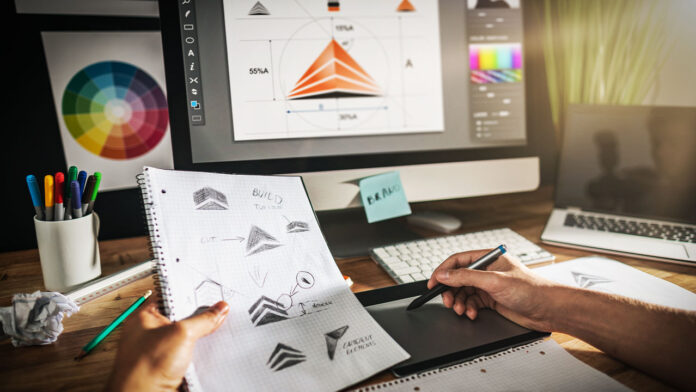In an increasingly visual world, the importance of graphic design cannot be overstated. From captivating logos and eye-catching advertisements to stunning websites and engaging social media content, graphic designing plays a pivotal role in how businesses communicate their brand identity and connect with their audience.
The power of graphic design lies in its ability to transform abstract ideas and visions into concrete visual representations that resonate, inspire, and drive action.
The Essence of Graphic Design
At its core, graphic design is the art of visual communication. It combines creativity, technology, and strategic thinking to convey messages through images, typography, colors, and layouts. At aksoftco, graphic designers use their skills to create visual content that informs, entertains, and influences viewers.
The significance of graphic design extends beyond aesthetics; it is about creating a meaningful connection between the brand and its audience. When done effectively, graphic design can enhance the user experience, evoke emotions, and reinforce brand identity, making it a crucial component of any marketing strategy.
Key Benefits of Graphic Designing
1. Establishing Brand Identity
Graphic design is instrumental in establishing a strong brand identity. A well-designed logo, cohesive color palette, and consistent typography create a visual language that reflects the brand’s values and personality. This visual identity helps businesses stand out in a crowded market and fosters brand recognition.
When consumers encounter consistent and professional branding across various touchpoints be it packaging, advertisements, or digital platforms they are more likely to trust and remember the brand. Strong branding through graphic design also helps differentiate a business from its competitors, making it more appealing to potential customers.
2. Enhancing Communication
Graphic design simplifies complex ideas and information. Visuals are processed faster than text, making it easier for audiences to grasp and retain information. Infographics, diagrams, and charts can convey data in an engaging and digestible format, facilitating better understanding and retention.
Effective graphic design enhances communication by breaking down barriers and making messages clearer and more impactful. This is particularly valuable in marketing materials, presentations, and educational content where clarity is essential.
3. Driving Engagement and Conversions
In the digital landscape, engaging visual content is key to capturing the audience’s attention. Well-crafted graphics such as social media posts, banners, and email campaigns—can significantly increase engagement rates and drive conversions.
When users are presented with visually appealing content, they are more likely to interact with it, whether by liking, sharing, or clicking through to a website. High-quality visuals can enhance the perceived value of a brand and encourage consumers to act, leading to increased sales and customer loyalty.
4. Creating Memorable Experiences
Humans are inherently visual creatures, and compelling graphic design can create memorable experiences for users. From a beautifully designed website to an intricately crafted product package, the visual elements of a brand contribute to how consumers perceive and remember it.
Memorable experiences foster emotional connections, which can lead to long-lasting customer relationships. By utilizing thoughtful graphic design, brands can create positive associations that resonate with their audience long after the initial interaction.
The Role of Graphic Design in Different Industries
Graphic design is a versatile discipline that spans across various industries. Here’s how it influences different sectors:
1. Marketing and Advertising
In marketing, graphic design is crucial for creating impactful advertisements that capture attention and convey brand messages effectively. Whether through print ads, digital campaigns, or social media promotions, eye-catching visuals are essential for driving consumer interest and action.
2. Web Design and Development
A website serves as a brand’s digital storefront, and effective graphic design plays a significant role in user experience. A well-designed website that prioritizes aesthetics, navigation, and responsiveness can enhance user satisfaction, encourage longer visits, and boost conversion rates.
3. Product Packaging
Packaging is often the first point of contact between a product and a consumer. Creative graphic designing in packaging can entice customers to pick up a product off the shelf. It communicates essential information while also conveying the brand’s identity and values.
4. Corporate Branding
Graphic design is fundamental in developing corporate branding materials, such as business cards, letterheads, and presentations. These materials reflect a company’s professionalism and attention to detail, enhancing the overall perception of the brand in the eyes of clients and partners. more
The Creative Process of Graphic Designing
The journey from vision to reality in graphic design involves several stages:
1. Research and Discovery
Understanding the client’s goals, target audience, and competitive landscape is essential. This research phase sets the foundation for effective design decisions.
2. Concept Development
Based on the research, designers brainstorm and develop concepts that align with the client’s vision. Sketching ideas and creating mood boards can help visualize potential directions.
3. Design Execution
Once a concept is approved, designers begin the actual design process. This involves creating digital illustrations, selecting typography, and choosing color palettes that embody the brand’s identity.
4. Feedback and Revisions
Collaboration with the client is crucial during this phase. Feedback is gathered, and necessary revisions are made to ensure that the final design meets the client’s expectations and objectives.
5. Final Delivery
Once the design is finalized, it is prepared for production or digital implementation. This includes delivering various file formats and ensuring that the design is optimized for its intended use.
Conclusion
The power of graphic design lies in its ability to transform visions into reality, creating meaningful connections between brands and their audiences. Visit our website aksoftco.com to provide graphic designing services.
Through effective visual communication, businesses can establish their identities, enhance engagement, and leave lasting impressions on consumers.
In a visually driven world, investing in professional graphic design is not just an option; it’s a necessity for any business looking to thrive. By leveraging the creative potential of graphic design, brands can elevate their marketing strategies, capture attention, and foster deeper connections with their target audiences. Embracing the art of graphic design is a step toward unlocking the full potential of your brand and ensuring that your vision resonates in a crowded marketplace.
